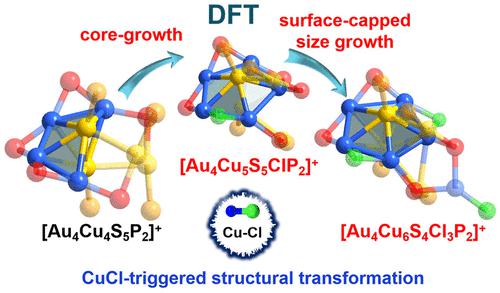Our official English website, www.x-mol.net, welcomes your
feedback! (Note: you will need to create a separate account there.)
Size Growth of Au4Cu4: From Increased Nucleation to Surface Capping
ACS Nano ( IF 15.8 ) Pub Date : 2023-04-28 , DOI: 10.1021/acsnano.3c01238
Zidong Lin 1 , Ying Lv 1 , Shan Jin 1 , Haizhu Yu 1 , Manzhou Zhu 1
ACS Nano ( IF 15.8 ) Pub Date : 2023-04-28 , DOI: 10.1021/acsnano.3c01238
Zidong Lin 1 , Ying Lv 1 , Shan Jin 1 , Haizhu Yu 1 , Manzhou Zhu 1
Affiliation

|
The size conversion of atomically precise metal nanoclusters is fundamental for elucidating structure-property correlations. In this study, copper salt (CuCl)-induced size growth from [Au4Cu4(Dppm)2(SAdm)5]+ (abbreviated as [Au4Cu4S5]+) to [Au4Cu6(Dppm)2(SAdm)4Cl3]+ (abbreviated as [Au4Cu6S4Cl3]+) (SAdmH = 1-adamantane mercaptan, Dppm = bis-(diphenylphosphino)methane) was investigated via experiments and density functional theory calculations. The [Au4Cu4S5]+ adopts a defective pentagonal bipyramid core structure with surface cavities, which could be easily filled with the sterically less hindered CuCl and CuSCy (i.e., core growth) (HSCy = cyclohexanethiol) but not the bulky CuSAdm. As long as the Au4Cu5 framework is formed, ligand exchange or size growth occurs easily. However, owing to the compact pentagonal bipyramid core structure, the latter growth mode occurs only for the surface-capped [Au4Cu6(Dppm)2(SAdm)4Cl3]+ structure (i.e., surface-capped size growth). A preliminary mechanistic study with density functional theory (DFT) calculations indicated that the overall conversion occurred via CuCl addition, core tautomerization, Cl migration, the second [CuCl] addition, and [CuCl]-[CuSR] exchange steps. And the [Au4Cu6(Dppm)2(SAdm)4Cl3]+ alloy nanocluster exhibits aggregation-induced emission (AIE) with an absolute luminescence quantum yield of 18.01% in the solid state. This work sheds light on the structural transformation of Au–Cu alloy nanoclusters induced by Cu(I) and contributes to the knowledge base of metal-ion-induced size conversion of metal nanoclusters.
中文翻译:

Au4Cu4 的尺寸增长:从增加成核到表面覆盖
原子精确金属纳米团簇的尺寸转换是阐明结构-性质相关性的基础。在这项研究中,铜盐 (CuCl) 诱导尺寸从 [Au 4 Cu 4 (Dppm) 2 (SAdm) 5 ] +(缩写为[Au 4 Cu 4 S 5 ] +)到 [Au 4 Cu 6 (Dppm) ) 2 (SAdm) 4 Cl 3 ] +(简写为[Au 4 Cu 6 S 4 Cl 3 ] +) (SAdmH = 1-金刚烷硫醇,Dppm = 双-(二苯基膦基)甲烷) 通过实验和密度泛函理论计算进行了研究。[ Au 4 Cu 4 S 5 ] +采用具有表面空腔的有缺陷的五角双锥核结构,可以很容易地用空间位阻较小的 CuCl 和 CuSCy(即核生长)(HSCy = 环己硫醇)填充,但不能填充体积庞大的 CuSAdm . 只要形成Au 4 Cu 5框架,就很容易发生配体交换或尺寸增长。然而,由于紧凑的五角双锥核心结构,后一种生长模式仅发生在表面覆盖的 [Au 4 Cu 6 (Dppm)2 (SAdm) 4 Cl 3 ] +结构(即,表面覆盖尺寸生长)。密度泛函理论 (DFT) 计算的初步机理研究表明,整体转化是通过 CuCl 添加、核心互变异构化、Cl 迁移、第二次 [CuCl] 添加和 [CuCl]-[CuSR] 交换步骤发生的。[Au 4 Cu 6 (Dppm) 2 (SAdm) 4 Cl 3 ] +合金纳米团簇表现出聚集诱导发光 (AIE),在固态下的绝对发光量子产率为 18.01%。这项工作阐明了由 Cu(I) 诱导的 Au-Cu 合金纳米团簇的结构转变,并有助于建立金属离子诱导的金属纳米团簇尺寸转换的知识库。
更新日期:2023-04-28
中文翻译:

Au4Cu4 的尺寸增长:从增加成核到表面覆盖
原子精确金属纳米团簇的尺寸转换是阐明结构-性质相关性的基础。在这项研究中,铜盐 (CuCl) 诱导尺寸从 [Au 4 Cu 4 (Dppm) 2 (SAdm) 5 ] +(缩写为[Au 4 Cu 4 S 5 ] +)到 [Au 4 Cu 6 (Dppm) ) 2 (SAdm) 4 Cl 3 ] +(简写为[Au 4 Cu 6 S 4 Cl 3 ] +) (SAdmH = 1-金刚烷硫醇,Dppm = 双-(二苯基膦基)甲烷) 通过实验和密度泛函理论计算进行了研究。[ Au 4 Cu 4 S 5 ] +采用具有表面空腔的有缺陷的五角双锥核结构,可以很容易地用空间位阻较小的 CuCl 和 CuSCy(即核生长)(HSCy = 环己硫醇)填充,但不能填充体积庞大的 CuSAdm . 只要形成Au 4 Cu 5框架,就很容易发生配体交换或尺寸增长。然而,由于紧凑的五角双锥核心结构,后一种生长模式仅发生在表面覆盖的 [Au 4 Cu 6 (Dppm)2 (SAdm) 4 Cl 3 ] +结构(即,表面覆盖尺寸生长)。密度泛函理论 (DFT) 计算的初步机理研究表明,整体转化是通过 CuCl 添加、核心互变异构化、Cl 迁移、第二次 [CuCl] 添加和 [CuCl]-[CuSR] 交换步骤发生的。[Au 4 Cu 6 (Dppm) 2 (SAdm) 4 Cl 3 ] +合金纳米团簇表现出聚集诱导发光 (AIE),在固态下的绝对发光量子产率为 18.01%。这项工作阐明了由 Cu(I) 诱导的 Au-Cu 合金纳米团簇的结构转变,并有助于建立金属离子诱导的金属纳米团簇尺寸转换的知识库。







































 京公网安备 11010802027423号
京公网安备 11010802027423号